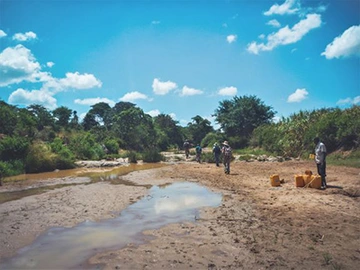Reconciling human livelihood needs and nature conservation: Interdisciplinary field courses in Kenya’s forest biodiversity hotspots
December 11, 2019.
Kenya hosts unique forest ecosystems that are under threat from deforestation and degradation. The four-year project ‘Reconciling human livelihood needs and nature conservation in Kenya’, funded by the German Academic Exchange Service (DAAD), aimed at understanding biodiversity and land use patterns in three Kenyan forest biodiversity hotspots. The overall goal was to develop approaches for forest conservation that take into account local livelihood needs. Cooperation and exchange between German and Kenyan University staff and students were key to the project.
We conducted international and interdisciplinary field courses in three areas: the riparian forest remnants in the semi-arid Kitui County, the coastal forest in the Arabuko-Sokoke National Park, and the moist montane forest in the Taita Hills. In each area, teams of students and senior researchers collected the data required for a comprehensive forest landscape assessment. This included the study of species distributions (e.g., plants, butterflies, birds, small mammals) and ecosystem functions (e.g., seed removal, predation of artificial caterpillars) in and outside the forest, evaluation of land cover and tenure systems, and interview surveys to elicit local perceptions of landscape management and nature conservation.
Ongoing forest degradation and loss of biodiversity
In all study areas, the high dependency of the local population on subsistence agriculture, fuel wood, and timber undermined the enforcement of formal forest conservation measures. Despite the ongoing forest degradation, there was a sharp divide between the remaining natural forest characterized by high species diversity, including endemic and threatened species, and the surrounding agricultural areas that supported fewer species, and especially fewer specialized species. In terms of vegetation for example, 80% of all individual trees on agricultural land in the Taita Hills were exotic, mainly Grevillea and Eucalyptus. Though an important economic asset, exotic trees also may have negative biodiversity effects.
Approaches for forest conservation
Solutions for forest conservation must be tailored to the particular cultural and ecological circumstances of each area. Generally, enhanced communication and collaboration between governmental and community organizations is required to clarify forest tenure, rights of use, and benefit-sharing issues. Next to protecting the remaining natural forest, it is key to improve local livelihoods. Training and capacity building for farmers and community organizations can support local communities in becoming the custodians of their own environment. This may include the promotion of agroforestry systems and useful indigenous tree species, the development of value chains for local produce, and community tourism initiatives. We hope to have inspired the students who participated in this project to consider these issues in their future careers.
For more information about the project,see: biodiversitynetworkkenya.wordpress.com
About the authors:
Christine B. Schmitt is a senior researcher at ZEF. Contact: cschmitt(at)uni-bonn.de
Marianne Maghenda is Dean of the School of Agriculture, Earth and Environmental Science, Taita Taveta University, Kenya.



